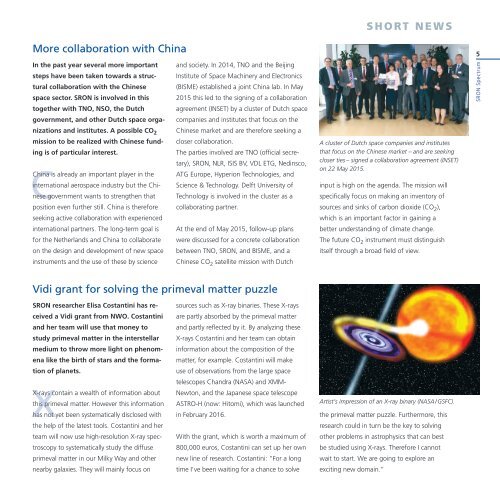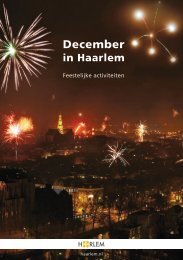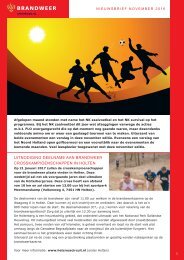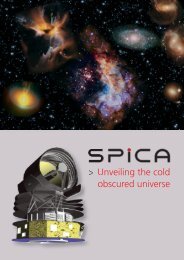SRON_Spectrum_2016
You also want an ePaper? Increase the reach of your titles
YUMPU automatically turns print PDFs into web optimized ePapers that Google loves.
More collaboration with China<br />
In the past year several more important<br />
steps have been taken towards a structural<br />
collaboration with the Chinese<br />
space sector. <strong>SRON</strong> is involved in this<br />
together with TNO, NSO, the Dutch<br />
government, and other Dutch space organizations<br />
and institutes. A possible CO 2<br />
mission to be realized with Chinese fund -<br />
ing is of particular interest.<br />
CChina is already an important player in the<br />
international aerospace industry but the Chinese<br />
government wants to strengthen that<br />
position even further still. China is therefore<br />
seeking active collaboration with experienced<br />
international partners. The long-term goal is<br />
for the Netherlands and China to collaborate<br />
on the design and development of new space<br />
instruments and the use of these by science<br />
and society. In 2014, TNO and the Beijing<br />
Institute of Space Machinery and Electronics<br />
(BISME) established a joint China lab. In May<br />
2015 this led to the signing of a collaboration<br />
agreement (INSET) by a cluster of Dutch space<br />
companies and institutes that focus on the<br />
Chinese market and are therefore seeking a<br />
closer collaboration.<br />
The parties involved are TNO (official secretary),<br />
<strong>SRON</strong>, NLR, ISIS BV, VDL ETG, Nedinsco,<br />
ATG Europe, Hyperion Technologies, and<br />
Science & Technology. Delft University of<br />
Tech nology is involved in the cluster as a<br />
collaborating partner.<br />
At the end of May 2015, follow-up plans<br />
were discussed for a concrete collaboration<br />
between TNO, <strong>SRON</strong>, and BISME, and a<br />
Chinese CO 2 satellite mission with Dutch<br />
S H O R T N E W S<br />
A cluster of Dutch space companies and institutes<br />
that focus on the Chinese market – and are seeking<br />
closer ties – signed a collaboration agreement (INSET)<br />
on 22 May 2015.<br />
input is high on the agenda. The mission will<br />
specifically focus on making an inventory of<br />
sources and sinks of carbon dioxide (CO 2 ),<br />
which is an important factor in gaining a<br />
better understanding of climate change.<br />
The future CO 2 instrument must distinguish<br />
itself through a broad field of view.<br />
5<br />
<strong>SRON</strong> <strong>Spectrum</strong><br />
Vidi grant for solving the primeval matter puzzle<br />
<strong>SRON</strong> researcher Elisa Costantini has received<br />
a Vidi grant from NWO. Costantini<br />
and her team will use that money to<br />
study primeval matter in the interstellar<br />
medium to throw more light on phenom -<br />
ena like the birth of stars and the formation<br />
of planets.<br />
XX-rays contain a wealth of information about<br />
this primeval matter. However this information<br />
has not yet been systematically disclosed with<br />
the help of the latest tools. Costantini and her<br />
team will now use high-resolution X-ray spectroscopy<br />
to systematically study the diffuse<br />
primeval matter in our Milky Way and other<br />
nearby galaxies. They will mainly focus on<br />
sources such as X-ray binaries. These X-rays<br />
are partly absorbed by the primeval matter<br />
and partly reflected by it. By analyzing these<br />
X-rays Costantini and her team can obtain<br />
information about the composition of the<br />
matter, for example. Costantini will make<br />
use of observations from the large space<br />
tele scopes Chandra (NASA) and XMM-<br />
Newton, and the Japanese space telescope<br />
ASTRO-H (now: Hitomi), which was launched<br />
in Febru ary <strong>2016</strong>.<br />
With the grant, which is worth a maximum of<br />
800,000 euros, Costantini can set up her own<br />
new line of research. Costantini: “For a long<br />
time I’ve been waiting for a chance to solve<br />
Artist’ s impression of an X-ray binary (NASA/GSFC).<br />
the primeval matter puzzle. Furthermore, this<br />
research could in turn be the key to solving<br />
other problems in astrophysics that can best<br />
be studied using X-rays. Therefore I cannot<br />
wait to start. We are going to explore an<br />
exciting new domain.”






